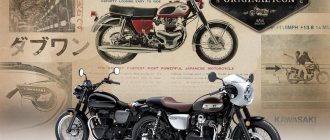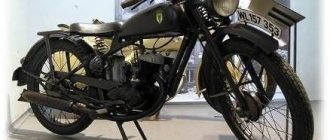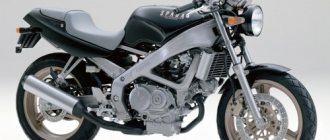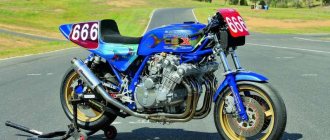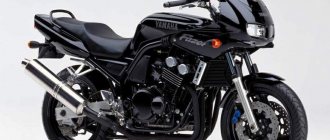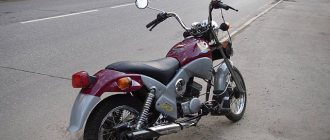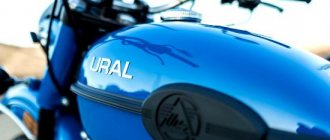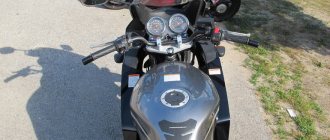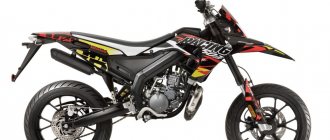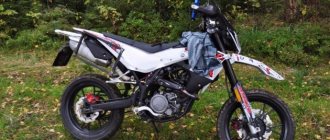Single cylinder chopper
It just so happens that most people associate a chopper with a V-shaped 2-cylinder engine.
Such legendary brands as Indian and Harley-Davidson made their contribution to the formation of such an image, and this image has long been firmly entrenched in the minds of bikers. However, there are both fans of boxer choppers made from grandfather's Ural, and supporters of motorcycles with in-line engines - for example, Triumph America with an in-line "two". or Kawasaki Eliminator 400 with “four”. But single-cylinder choppers are often forgotten, and completely undeservedly. Of course, most single-cylinder motorcycles are intended primarily for beginners, as they have rather modest technical characteristics (we will tactfully keep silent about the evil motocross bikes). Another reason to buy such a model is a limited budget. Well, some are simply attracted by the aesthetics of a single-cylinder chopper... Why not?
Among models with modest engines with just one cylinder, Chinese motorcycles, choppers and more predominate. Chinese manufacturers generally have a habit of installing the same engine on a whole bunch of different models, from “chopper type” to “sportbike type”. A striking example is, for example, the BM 200 Classic, a lightweight chopper with a 200 cc engine, very popular among beginners due to its light weight and affordable price.
But two hundred “cubes” is frankly not enough for more or less experienced motorcyclists who are already starting to lack drive. Of course, choppers are not “adrenaline squeezers” anyway, but, you see, even a chopper can drive very cheerfully. Take a look, for example, at the Yamaha Warrior - under the rear wheel of this bike, the asphalt rolls up, and when starting from a traffic light, it can give odds to many sportbikes and road bikes!
Unfortunately for fans of single-cylinder choppers, there is little choice here. You will have to choose either among the aforementioned “Chinese” or among rare models like the Suzuki Savage, which exists in two versions - 400 and 650 cc. see. The latter, by the way, is very interesting - you can find this model in a completely fresh form, because this motorcycle, renamed Suzuki Boulevard S40 at the beginning of this century, lived an abnormally long life on the assembly line.
That's probably all there is to it when it comes to choice. Finally, let us remind fans of direct-flow exhausts that with a single-cylinder engine it is unlikely that it will be possible to achieve the solid roar of a volumetric V-twin. The operating speeds of 1-cylinder engines are higher and they work differently, so with an “empty” exhaust the sound will be very loud and, most likely, quite unpleasant to the ear.
Source
Taking inspiration from the American-built motorcycles of yesteryear, cruisers have long been the most popular and best-selling motorcycle style in North America, the world's largest motorcycle market. In an effort to meet the needs of cruiser-oriented customers in the United States and Canada, major manufacturers have poured enormous amounts of resources into the development, production and marketing of their respective lines of bikes.
And while this has led to a buyer's market being flooded with increasingly capable and affordable two-wheeled products, the sheer number of makes and models available can make shopping in this segment quite challenging. So, with that in mind, the list has been compiled from models that have been produced over the past few years. We’ll also explore what to look for and consider when shopping, and briefly dive into the history of the cruiser class, what qualities and factors make them unique.
History of Cruiser motorcycles
With the advent of the motorcycle, the industry grew rapidly, giving way to more advanced and high-performance two-wheeled models. Major motorcycle genres developed vigorously from the 1940s to the 1960s in different regions, establishing their own styles and interpretations of motorcycles. Including the USA, with its golden era of big V-Twin engines, thanks to manufacturers such as Crocker, Indian, Excelsior and Harley-Davidson.
US-based motorcycle companies not only used these designs in the mid-1900s, but also stated that they would serve as the visual inspiration for the lion's share of production motorcycles that were subsequently released - a trend that continues to this day. Along with the bike's relaxed riding position, ample torque and ease of touring, their quintessentially American aesthetic plays a big role in setting them apart from other styles of motorcycles and is a major selling point for the biker crowds. That's not to say that foreign manufacturers haven't tried to emulate the style or put a unique spin on it, although in general, cruisers are American at heart.
Indian Challenger
Honda motorcycles
This company is rightfully the leader of the global motor market; it is not for nothing that it ranks third in the list of the largest companies in Japan. It produces sportbikes for racers, enduro bikes for travelers, choppers for bikers, and so on. It's safe to say that Honda is the perfect combination of stylish design, modern technology and the highest quality.
The best Honda motorcycle models
Crosstourer is another modification of the model that is perfect for adult and confident men.
GL1800 Gold Wing is a touring bike that enjoys well-deserved popularity all over the world.
The CBR1000RR Fireblade is a powerful sportbike whose design combines many years of tradition and the latest fashion trends.
Cruisers with V-Twin engine
In the early days of the American motorcycle industry, manufacturers primarily used relatively primitive air-cooled single-cylinder powerplants, although in 1906 Indian produced the first American V-Twin model with a 39ci 42° tire. Harley's first production V-Twin model was released in 1909. In subsequent decades, various American brands, including Indian, experimented with other engine configurations, although the 1907 V-Twin became the archetype for American motorcycles.
Today, V-Twin engines are synonymous with American-made cruiser motorcycles, boasting a distinctive look that serves as the embellishment and centerpiece of virtually every production cruiser. And they offer an easily recognizable and distinct deep, throaty and rumbly exhaust sound. What's more, these large-displacement V-twin engines play a key role in the overall riding experience of American cruisers, with their broad, low-end grunt and firm stance. In recent years, foreign motorcycle companies have introduced cruiser models with other engine configurations, although even most of these are just variations of the longitudinally mounted V-Twin, such as the L-Twin-powered Ducati Diavel (and XDiavel) and the transversely-mounted V-Twin-powered Moto Guzzi .
Cruiser classes
While every model on this list is classified as a cruiser, there are actually several different styles of motorcycles in this segment. To shed some light on these differences, we've broken down the cruiser class into five main categories, each of which we'll briefly touch on immediately below.
Entry Level: As the name of this subgenre suggests, entry-level models are more affordable and more beginner-friendly. At least by American cruiser standards, these models have smaller engines that are more convenient for novice racers.
Tourer: Touring bikes aren't always ideal for city riding or commuting, but they're perfect for chewing up the miles on the open road. Touring models with powerful engines, long wheelbases, good riding position and high stability due to their enormous weight are ideal for long trips.
Bagger: Also called "chesters," baggers are an easily recognizable subgenre of cruisers with large fairings, hard luggage, and spacious passenger seating. Similar to touring models, baggers are also incredibly suitable for long-distance travel. With plenty of amenities such as heated grips, cruise control and on-board infotainment systems, stereo and GPS navigation systems.
Hyper-Cruiser: Hyper-Cruiser models are a style of cruising motorcycle that have been designed from the ground up to provide noticeably better performance than a regular cruiser. These high-performance offerings offer greater lean angle, better acceleration and cornering, and often feature components typically found on sport and superbike models.
Electric: Even though there are only a few production models at the moment, electric cruisers are almost certainly the next big trend in the cruiser world. While they lack the powerful rumble and exhaust note of a traditional petrol V-Twin, the electric powertrains still maintain the same ample low-end torque. The new EV cruiser class also tends to include the most advanced technology of any subgenre on this list.
Triumph Rocket 3
Classic Kawasaki motorcycle with 12-cylinder engine (10 photos + 2 videos)
Adding more cylinders to motorcycle engines is no feat, but one man has done it time and time again. This is the creation of British customizer Alan Millyard. He has built many motorcycles, all with the utmost care and detail.
In Allen's living room, where you'd expect a coffee table, he keeps a large Suzuki and a 1000cc Kawasaki.
He has many non-production motorcycles. In his collection you can find a 1600 cc Kawasaki with a V8 and a magnificent 12-cylinder motorcycle with a displacement of 2300 cc. Kawasaki V8 1600
Despite the Kawasaki badges, this company did not produce anything like it. All of them were created by Alain.
The V12 is the latest bike in his customizing journey, which began when he built a Mini engine into a BSA frame as a teenager. His early fascination with Kawasaki two-strokes led him to build inline four, five and six cylinder engines based on factory models. Alain then turned his attention to four-stroke engines, converting a 50cc Honda into a V-Twin that now sits in his bedroom. He made it over a weekend, in front of an audience at a bike show. Then came the amazing V8s. As usual, he did not make drawings; he thought through all the projects in his head while working on motorcycles.
To reduce overall length to a minimum, the cylinder banks had a 70-degree camber. The crankshaft is standard; opposite cylinders from different blocks were attached to the same axis. Inline cylinder blocks were not aesthetically acceptable to Allen, so he made new cylinder liners with offset bores of smaller diameter. Thus, the engine is offset slightly less than twice, but still looks symmetrical. Because the rear cylinder head was turned the other way, a new camshaft drive was designed, and the frame was lengthened five inches to accommodate the engine.
The V8 has clocked up thousands of miles without any breakdowns. Alain drove it all over Europe, covered many race tracks, and even won a race on the Isle of Man! Estimated power is approximately 130 hp. at 8000 rpm, while the bike weighs about 40 kg. larger than its predecessor Z1.
Naturally, the V8 motorcycle inspired his next project, which they said was impossible. It was based on the six-cylinder Kawasaki Z1300, a monster bike released in 1979. Although the conversion to a V12 uses the same method as a V8, the Z1300's unusual engine layout made the job even more challenging. The process may take several pages to describe, but rest assured that it was not easy. For months on end, after a full day of work as an engineer for the Department of Defense, Allen disappears into his small garage for five hours assembling an engine. The cylinders again have a 70 degree camber, but this time they are canted 35 degrees.
The job was made more difficult by the fact that the Kawasaki engine has a two-speed camshaft drive, a three-speed transmission and narrow journal bearings. Everything has been reworked, with aftermarket connecting rods added and low pressure roller bearings included with a high volume lubrication system. As with the V8, the original frame needed to be lengthened, this time by about four inches. The fuel tank has also been enlarged. How? He divided it into two parts and welded the central part.
Even upon closer inspection, these models look like factory ones. This is engineering and this is art. The true art of creating original motorcycles.
Starting with a small volume
You wouldn't want to learn to drive behind the wheel of a Ford F-250 Super Duty or any other massive pickup truck, and by the same token, you almost certainly shouldn't start your career in a full-size cruiser. Even with entry-level models with roughly liter-sized engines and curb weights exceeding 200kg, cruisers are simply not very suitable for beginners. With tons of power and half the weight of a Fiat 500, cruisers can be extremely unforgiving and difficult to handle, making them perhaps one of, if not the worst choice for inexperienced racers.
Starting on a cruiser that is too big and/or powerful is not only dangerous, it will hinder your growth as a rider and make the lion's share of your experience in the saddle extremely nerve-wracking. If you're still set on starting your two-wheeled career on a cruiser, the good news is that there are plenty of beginner-friendly cruiser models on the market today. These motorcycles have smaller engines and thinner curb weights, while maintaining the appearance of traditional cruisers. Once you develop your technique and riding skills, you can always upgrade to a larger cruiser in the future.
Yamaha motorcycles
Yamaha entered the market later than Honda and has been its main competitor ever since. The main feature of Yamaha motorcycles is a unique design that minimizes the weight of the vehicle. For this reason, even miniature girls and boys who have barely crossed the threshold of adulthood confidently ride in the saddle of such bikes.
The best Yamaha motorcycle models
YBR 125 is a motorcycle with a small engine capacity, more like a moped. However, this is a full-fledged bike that incorporates all the advantages of Yamaha technology. If a person is just starting to learn to ride a motorcycle, this model will be an excellent choice.
The YZF-R1 is the choice of those who want a sports bike, but at the same time ride mostly in the city. The model is equipped with a 4-cylinder engine, and the front and rear suspensions have an adjustment function, which allows you to customize the motorcycle to suit you.
YZF-R6 is currently the most technologically advanced Yamaha model. What does this mean? It's simple - the motorcycle is equipped with a variety of electronic devices that allow the driver to not make much effort while driving. The YZF-R6 is a pleasure to ride.
What to look for when buying a cruiser
Now that you're familiar with the different subgenres available and a little history about cruisers, let's dive into the five most important aspects to consider when purchasing a motorcycle in this class (in order of importance).
Intended Use: No matter what kind of motorcycle you're looking for, your search for a new snowmobile should always be based on what you plan to use, and that's no less true for cruiser bikes. If you plan to use it for your daily commute, you'll want something more nimble and maneuverable; for example, if you're going to be doing long hikes in the saddle, you'll probably want to consider an option with a rack.
Style: The enormous popularity of the cruise segment has led to the emergence of a variety of styles within the class. Some cruisers take a more vintage approach, drawing aesthetic influences from retro models from the mid-1900s, while other models take a more modern approach, with a more aggressive character and an overall more modern design language. It's worth checking out all the different stylistic options before making a purchasing decision.
Moto Guzzi MGX-21
Engine Power: One of the most defining elements of a cruiser is its engine, and its torque and horsepower. Not only will you want to consider whether the motor size and power are suitable for your intended use, but also whether you are capable of operating the particular motor correctly and safely. Additionally, engine mechanics and technology can vary greatly even without today's market, with some companies using much more advanced powertrains than others.
Yamaha Company History
After the Meiji Revolution of 1867-1868, the time of change that swept Japan led to a change in culture, including music. This trend was caught by Taraguchi Yamaha, who founded the Nippon Gakki company for the production of “European” musical instruments. During World War II, Nippon Gakki produced aircraft parts, and after the defeat, the equipment purchased for this purpose sat idle for several years until members of the board of directors came up with the idea of invading the rapidly growing market for personal transportation. The surname of the company's founder was chosen as a trademark, but the emblem remained musical - three crossed tuning forks. The first Yamaha YA-1 motorcycle, introduced in January 1955, was simply copied from the German DKV RT 125, although with some changes (for example, a four-speed gearbox instead of a three-speed). The single-cylinder two-stroke engine (123 cm3, 5.6 hp) was installed in a single tubular frame, with a telescopic fork at the front and spark plug suspension at the rear. Almost immediately, the 174 cc modification “YC-1” appeared, and six months later the motorcycle department was allocated to (Yamaha Motor Co.). Already in 1956, the 125 cc motorcycle was radically modernized: the “YA-2” model was boosted to 6.8 hp. engine and a new chassis with a spinal stamped frame, short-link front fork and pendulum rear suspension. And in 1957, the “YD-1” motorcycle was released with a two-cylinder two-stroke engine (247 cm3, 14.5 hp), copied from the German model “Adler MB 250”, a four-speed gearbox, a completely closed final drive chain, and a backbone frame , front “telescope” and pendulum rear suspension. The Japanese market received Yamaha motorcycles well, so the company's management dared to challenge the largest manufacturer, the Honda concern. But the top Yamaha model was not up to par with its rival: it lacked dynamics, and the rigidity of the spinal frame was too low. Therefore, in 1959, the frame was reinforced with a tubular front brace (model “YD-2”), and soon the sports model “YDS-1” entered the market. By installing two carburetors, the engine power was increased to 20 hp, the motorcycle received a five-speed gearbox, and most importantly, a duplex tubular frame. With these motorcycles in 1960, the company entered world markets. In 1960, Yamaha offered two more new products to the domestic market: the MF-1 scooter with a single-cylinder two-stroke engine (49 cm3 3.5 hp) and the futuristic SC-1 scooter (174 cm3, 10.3 hp). c.) with an automatic hydromechanical transmission, transmission to the rear wheel by a cardan shaft and cantilever mounting of both wheels. The scooter turned out to be too expensive to produce and dropped out of the program within a year, but scooters gained popularity and, after countless upgrades, are now produced in several versions - with 2- and 4-stroke engines with a displacement of 49 to 89 cm3. Introduced in 1961, the 125 cc model “YA-5” (125 cm3, 10 hp) with a disc spool at the inlet no longer had anything in common with the DKV. The 1964 version "YA-6" received a cylinder inclined forward 45 degrees and a separate lubrication system. But the real bestseller was the 1963 lightweight motorcycle “YG-1” with a two-stroke engine (73 cm3, 6.5 hp) suspended from a stamped backbone frame. This machine became the basis of a whole family with engines from 49 to 89 cm3. An important stage in the development of two-cylinder models was the “YDS-3” version (246 cm3, 24 hp) presented in 1964 by Yamaha with a separate lubrication system. At the same time, the company launched the “YM-1” version (305 cm3, 26 hp). In 1967, a more powerful (29 hp) and advanced version of the “YDS-5” debuted: aluminum alloy cylinders with cast iron liners, dynastarter. The YM-1 was replaced by the YR-1 motorcycle (348 cm3, 36 hp). At the same time, Yamaha began production of 2-cylinder models with engines with a displacement of 89.124 and 180 cm3. The YDS series became the basis for the serial 250 cc racing motorcycles TD-1, which successfully participated in club racing, especially in the USA. And on the Grand Prix tracks in 1961, factory motorcycles with two-stroke air-cooled engines (single-cylinder 125 cc and two-cylinder 250 cc) with a disc spool at the inlet and a lightweight duplex frame appeared. At first, successes were modest, but in 1963 a new generation of motorcycles with liquid-cooled engines appeared. Japanese Fumio Ito took third place in the 250 cc class, and the following year Englishman Phil Read won the company's first world title. In 1965, Reed took to the track a new 250 cc motorcycle “RD-05A” with a 4-cylinder V-twin liquid-cooled engine and again became the world champion. A similar design “four” in the 125 cm3 class in 1967 led to the champion title of the Englishman Bill Ivy, and in 1968 Reed won in the 125 and 250 cm3 classes. The restrictions adopted by the FIM in 1968 prohibited the use of such complex designs as four-cylinder engines in the 125 and 250 cm3 classes. But they only played into the hands of Yamaha - remember the serial racing “two-cylinder” engines! In 1969, the company introduced their modernized versions to the market: “TA-2” (124 cm3, 24 hp), “TD-2” (246 cm3, 44 hp) and “TR-2” (347 cm3 , 54 hp), and in 1970, independent rider Englishman Rod Gould became the world champion in the 250 cm3 class on a production motorcycle. In total, these machines and their direct descendants from 1970 to 1986 won 14 championship titles in the 125, 250 and 350 cm3 classes. Off-road competitions gained in the 60s no less popularity than road racing. This provoked the emergence of numerous modifications of road motorcycles, as adapted for movement on dirt roads - the so-called scramblers (these in the Yamaha program were the single-cylinder “70 YP-1” of 1965 and the two-cylinder “305 YDS-3C” of 1966). The second direction was proposed by some European companies - off-road sports motorcycles adapted for travel on roads. Combining the two, Yamaha in 1968 first offered the market what would soon be called a dual-purpose motorcycle (maxi-enduro) - a machine equally well suited to travel on any road. The DT-1 model was distinguished by a flexible single-cylinder two-stroke engine (246 cm3, 18.5 hp), a 5-speed gearbox, very light (the motorcycle weighed 112 kg) and a durable duplex tubular frame, large (240 mm ) ground clearance and long-travel suspensions. The car instantly became a bestseller, caused many imitations, and by the beginning of the 70s, Yamaha itself included similar models with engines with a displacement of 49 to 397 cm3. In 1971, the base “DT 250” received an upgraded engine with a reverse reed valve at the intake, which not only increased power to 23 hp, but also significantly improved torque characteristics at low and medium speeds. The technical solution itself has been known almost since the advent of the two-stroke engine, but only Yamaha engineers managed to achieve its 100% performance. Soon, almost all two-stroke engines of the concern acquired this innovation, and now it is considered an indispensable attribute of a two-stroke engine. Interest in off-road competitions led to the appearance of motorcycles from the Japanese concern on the tracks. At first these were conversions of dual-purpose motorcycles, but in 1971 the special cross-country motorcycle “DT-1 MX” (250 cm3, 30 hp) debuted. In 1973, Swede Hakan Andersson brought the company its first world champion title in the 250 cc class. In 1974, a series of motocross motorcycles that received; index “YZ”, already covered cubic capacities of 8O, 125, 250 and 500 cm3. On cars of the 1975 model year, a rear suspension with a central gas-filled monoshock absorber and a triangular pendulum appeared. The cross-country series was complemented by the “TY” trial motorcycles that debuted in 1973 and the “IT” sports enduro series released in 1975. Although Yamaha until the end of the 60s produced motorcycles only with two-stroke engines, it caught the interest of European and American motorcyclists in large four-stroke engines in time. Moreover, such power units were not new to its specialists: the company had already produced engines for automobile concerns. At the end of 1969, Yamaha introduced its first four-stroke motorcycle, the XS-1. On the one hand, it was very similar to classic British motorcycles: an in-line engine (653 cm3, 53 hp) with two vertical cylinders, a tubular duplex frame. On the other hand, it was significantly superior to them in technical terms: an overhead camshaft with a chain drive, a gear motor transmission, a 5-speed gearbox in a block with the engine. Soon the car also included an electric starter and a front disc brake. The market received the new product with delight, and soon the company released two more two-cylinder models. The TX 750 model, which debuted in 1972, received an engine with increased displacement and power (743 cm3, 63 hp), with cylinders inclined forward and a vibration-reducing balance shaft (for the first time in motorcycle practice). A year later, the range was supplemented by the TX 500 model (498 cm3, 48 hp). It became the world's first production motorcycle since the 1930s to be equipped with four-valve cylinder heads. Four-stroke engines were not the only option for creating a superbike from Yamaha. In 1971, the company presented two prototypes at an exhibition in Tokyo: the RZ 201 with a twin-rotor engine producing 68 hp and the GL750-4 with a 743 cc four-cylinder in-line two-stroke liquid-cooled engine, boosted to 70 hp. They wisely remained prototypes, although the two-stroke engine became the basis for very successful racing cars in the 500 and 750 cc classes. Italian Giacomo Agostini won the first world champion title in the 500 cm3 class for the Japanese in 1975, and American Kenny Roberts won the 500 three times in a row - from 1978 to 1980. The fuel crisis that broke out in the 70s convinced the company's management that the chosen course was correct, and the range of four-stroke models began to rapidly expand. In 1975, three new families debuted. The middle class motorcycle “XS 360” received a two-cylinder in-line engine (358 cm3, 34 hp), coupled with a 6-speed gearbox. Soon its 250 cc, 27-horsepower brother, the XS 250, appeared. The dual-purpose motorcycle "XT 500", equipped with a single-cylinder four-stroke engine (499 cm3, 30 hp), opened new horizons for this class. If previously such machines were considered capable only of short forays into nature, the powerful and economical XT 500 quickly became a favorite of motorcycle travelers. It was these motorcycles that brought victories in the first Paris-Dakar rally marathons. Finally, in the same 1975, the not very successful TX 750 was replaced by the XS 750 with an in-line three-cylinder four-stroke engine (747 cm3, 64 hp) and a cardan drive to the rear wheel. The leader of the model range became in 1977 the “XS1100” with an in-line four-cylinder engine with a displacement of 1102 cm3 and a power of 95 hp; this car developed a speed of 220 km/h, reaching 100 km/h from a standstill in 4 seconds. The concern's specialists skillfully predicted the needs of the market, often ahead of their rivals. Thus, already in the second half of the 70s, the company began manufacturing custom motorcycles, equipped in the American fashion with high handlebars, saddles with a “step” and teardrop-shaped gas tanks. In 1977, the first neoclassic was released - the SR 500 road motorcycle, very similar to traditional British motorcycles, but with a modified XT 500 engine. Subsequently, the idea was developed into economical motorcycles with single-cylinder four-stroke engines with a displacement of 124, 185 and 249 cm3, which were very popular in third world countries. But the greatest success of the Yamaha concern's marketers is the “motorcycle for housewives” introduced in 1977, the economical and extremely easy-to-use scooter “Passol”: an open frame at the top, a front shield and flooring underfoot, a single-cylinder two-stroke engine (49 cm3, 2.3 hp) without gearbox, automatic centrifugal clutch, chain guard as a rear suspension swingarm and 10-inch wheels. The model appeared so timely that it provoked a surge of interest in such cars, which in the 80s was called the “roller renaissance.” Yamaha's success caused many imitations, but the Japanese concern remained on the crest of the wave it caused. Since 1981, he began installing automatic V-belt variators on his scooters. In 1982, the concern released the first cruising class scooter, Cygnus, with a single-cylinder four-stroke engine (171 cm3.15 hp). A year later, the Tracy sports scooter with a liquid-cooled two-stroke engine (123 cm3, 16 hp) was launched. At the same time, the concern launched the extremely popular 50 cc Jog scooter; by 1990, 1.5 million cars of this model were sold. The 80s brought the debuts of a new generation of motorcycles - such as the RD 350 LC (in Japan - RZ350) introduced in 1980 with a two-cylinder two-stroke liquid-cooled engine (347 cm3, 45 hp) with reed valves on intake, 6-speed gearbox, tubular duplex frame, cast wheels and monoshock rear suspension. A 250 cc 35-horsepower version was also produced. After modernization in 1982, the motorcycle received a space frame made of rectangular pipes, a rear suspension with progressive characteristics and boosted to 55 hp. a motor with special dampers in the exhaust system - power valves. This “rocket” accelerated to 190 km/h, reaching 100 km/h from a standstill in 5 seconds. But even these achievements paled in front of the RD 500LC, which debuted in 1983 - a real racing replica with a four-cylinder V-shaped two-stroke engine (499 cm3, 87 hp), a maximum speed of 223 km/h and acceleration to “hundreds” in 4 seconds . In those same years, the company released a series of on-road and off-road motorcycles with single-cylinder two-stroke liquid-cooled engines with a displacement from 49 to 195 cm3. The debut from Yamaha in 1980 of two motorcycles with a spinal stamped frame, rear, mono-suspension, cardan transmission and a two-cylinder V-shaped four-stroke air-cooled engine was sensational: the “XV 750 Special” (748 cm3, 60 hp), stylized in the American spirit. s.) and the classic “XV 1000 TR-1” (981 cm3, 70 hp). The “Classic” quickly disappeared from the range, but the Americanized model marked the beginning of an extremely popular family of cruisers, which since 1981 has been called “Virago” and covers models with engines with a displacement of 535 to 1063 cm3. In 1987, the family was supplemented by a model with a technically similar engine (248 cm3, 23 hp), a chain drive to the rear wheel and a tubular duplex frame. After another ten years, a 124 cc 10-horsepower version appeared. The XZ family, introduced in 1981, also had two-cylinder V-shaped four-stroke liquid-cooled engines, but technically more sophisticated - with two camshafts and four valves in each head. In the 552 cc version, this engine developed 64 hp, in the 398 cc version - 45 hp. But road sports motorcycles with these engines were not very successful and disappeared from the scene by the middle of the decade. Much greater success was achieved by road sports motorcycles with new four-cylinder in-line air-cooled engines with double overhead camshafts and 4-valve cylinder heads. This series was opened in 1979 by the XJ 650 motorcycle (653 cm3, 73 hp, 195 km/h). A year later, options appeared with engines with a displacement of 398, 528 and 748 cm3. Two “younger” cars had a chain main drive, two “older” ones had a driveshaft. In 1981, Yamaha introduced a version of the 653 cc machine, in which, due to turbocharging, the engine power was increased to 85 hp. The XJ 650 Turbo also featured a large fairing that covered the front of the motorcycle. In 1982, the XJ 900 version debuted (853 cm3, 97 hp). The concern introduced two touring motorcycles in 1983. The sports-tourist “FJ1100” had a four-cylinder in-line air-cooled engine (1097 cm3, 125 hp), a semi-fairing with a large windshield and a spoiler. The luxury tourer “XVZ 12TD Venture” was equipped with a four-cylinder V-shaped liquid-cooled engine (1198 cm3, 97 hp), covering most of the car with a lining, three luggage cases, a stereo radio and an on-board computer. Boosted to 145 hp. The same engine was installed in the chassis of the V-Max motorcycle that appeared in 1984, an incredible mixture of cruiser and dragster. The adventures of the V-4 engine did not end there. Derated to 74 hp. The 1294 cc version found itself in the chassis of the classic cruiser XVZ 1300A Royal Star of 1995, and three years later, in a 97-horsepower version, in its touring version XVZ 13TF Royal Star Venture. Yamaha demonstrated a new concept for a road sports motorcycle in 1984. The FZ 750 model had an in-line 4-cylinder liquid-cooled engine (749 cm3, 100 hp), for the first time in motorcycle practice, equipped with 5-valve cylinder heads. The steel frame was made of rectangular pipes, the rear suspension with a monamortizer and a progressive characteristic. A logical continuation of this scheme was the “Genesis” series (Genesis) in 1986: a sports bike with a fairing of the Grand Prix and made of aluminum alloy diagonal frame Deltabox. The FZR 750 model received the engine of its predecessor without special changes, and the version of FZR 1000 - the engine with a working volume of 989 cm3 and a capacity of 135 hp. Two years later, the 1000-cow version was equipped with an adjustable exhaust system, which made it possible to raise power to 145 hp, Yamaha designers are distinguished by an enviable ability to create viable hybrids. 1988 BW's first off-road scooter, motorcycle on the BW 200n 1984, Symbiosis Sports and Enduro 850 1990, connecting the chassis of the classic motorcycle to the Sports Bay, FZS 600 Fazer (Fazer), worthy of mentioning. 1997. In 1992, the GTS 1000 tourist motorcycle was a technological breakthrough with a frame in the form of a Greek letter “Omega”, a lever front fork with separate control mechanisms and pressed fuel injection by a four -cylinder engine (1002 cm3, 100 hp). The YZ 400F motorcycle entered sports tracks in 1997 for the first time after a long break brought a four -stroke engine to the winners of the world championship in motocross. And the YAZF-R1 Sport Bike presented by Yamaha became the standard in its class: a compact chassis (motorcycle mass-only 177 kg) and a four-cylinder engine (998cm3.150 l). Today, Yamaha has a network of 60 factories located in 45 countries of the world, and takes second place in the world for the production of motorcycle equipment.
